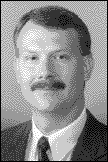From the executive Director – Sept 2004
 On page 263 of this issue of the
Journal of Swine Health and Production, there is an interview with Dr
Paula Kislak, president of the Association of Veterinarians for Animal Rights
(AVAR). Your
first reaction might be "Why is the AASV publishing an interview with
a veterinarian who supports animal rights?" That was
my reaction when the idea was first pitched to me. After careful consideration,
I decided that it was not only appropriate, but it
is greatly needed for AASV membership to see that animal rights activism is
happening within our profession.
On page 263 of this issue of the
Journal of Swine Health and Production, there is an interview with Dr
Paula Kislak, president of the Association of Veterinarians for Animal Rights
(AVAR). Your
first reaction might be "Why is the AASV publishing an interview with
a veterinarian who supports animal rights?" That was
my reaction when the idea was first pitched to me. After careful consideration,
I decided that it was not only appropriate, but it
is greatly needed for AASV membership to see that animal rights activism is
happening within our profession.
Like it or not, the reality is that there are members of our profession who completely and absolutely oppose the raising of animals for food. AVAR is an organization that is working without the attention of most food supply veterinarians. Just because they are not seen, it does not mean that they are not working in opposition to animal agriculture. The best analogy I can think of is a termite infestation: just because you can’t see termites, it does not mean that they are not damaging your house!
AVAR claims a membership of 12,000, but it is difficult to discern how they classify members. Suffice it to say that its membership includes both nonveterinarians and veterinarians who have donated money to the organization at some point. It has a grassroots structure that can generate signatures for petitions and letters to media and legislators. The strength of AVAR in a public debate is that it is often viewed as part of mainstream veterinary medicine. Having veterinarians as members and as spokespeople lends it credibility, whether deserved or not.
Surveys have consistently shown that veterinarians are trusted by the public. Can the public distinguish between an AASV veterinarian and an AVAR veterinarian? Each will certainly provide a different message, but I suspect that to a large extent the public is content to accept that a veterinarian is a veterinarian is a veterinarian. If that is true, then the future does not bode well unless we can differentiate ourselves and our message from the activists with an anti-agriculture message.
AVAR is an organization that is staunchly "anti" when it comes to agriculture. On the AVAR web site, they publicly proclaim that "The AVAR opposes in principle the raising of nonhuman animals for food and fiber." Their advocacy for "more humane means of raising nonhuman animals for human consumption" is only an intermediate step to the ultimate goal of a "purely plant-based diet and lifestyle." There is little chance for a meeting of the minds between organizations when the ultimate goal of one of the organizations is to destroy the industry of the other. However, we cannot just ignore or dismiss our opponents.
Our message needs to be consistent and concise: veterinarians value the well-being of the animals under our care. One of the greatest challenges we face is the need to deal with both the scientific and the emotional sides of the arguments. I have no doubt that we can successfully advocate for the use of science in animal welfare. It is our message to the emotional side of the argument that we need to hone. We need to concentrate on the fact that our agenda begins and ends with the animal’s health and well-being, not with a fund-raising campaign or an effort to impose a different lifestyle.
The AASV Pig Welfare Committee is working to develop a communication plan to address the complexities of the animal welfare debates in the swine industry and the veterinary medical profession. It is not an easy task. It is also a task that has to be ongoing in an ever-changing world. There is a great need to educate and inform not only the public but also our colleagues.
The AASV has several members who were appointed to the AVMA Sow Housing Task Force. This group will be conducting a thorough and objective review of the scientific evidence related to the impact of gestation stalls on the health and welfare of breeding sows, and it will make a recommendation of an appropriate position for the AVMA on the subject. AASV members serving on this task force include Drs Larry Firkins, Christa Irwin, Paul Sundberg, Lisa Tokach, and Bob Wills.
Individual practitioners can also demonstrate their concern for the welfare of the pigs in their respective practices. Your participation in the Swine Welfare Assurance ProgramSM (SWAPSM) will clearly demonstrate that we as a profession are taking steps to ensure that humane care is happening on the farm. SWAPSM concentrates on the pig and its care, not on billboards and legislation. The anti-agriculture groups have nothing even close to SWAPSM in terms of programming that is effectively and directly ensuring the appropriate care and well-being of animals on the farm.
As participants in animal agriculture, swine veterinarians have come to expect that we have different agendas from those held by the anti-agriculture organizations. However, it hits even closer to home when differing agendas generate attacks on agriculture from within our own profession.
— Tom Burkgren